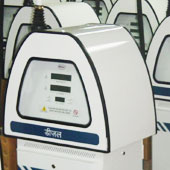The Bullet design was achieved by following the six criteria that form the backbone for innovation by design process. The criteria are elaborated below as:
• The Cause - Identifying the Need:
After L&T’s success, it became very difficult for MIDCO to compete in the market any more. MIDCO is a Mumbai based company. The CEO approached Prof. B. K. Chakravarthy who was at that time Asst. Professor at IIT Delhi. The project was undertaken after the stipulated 6 years of market life of Z-line. In the context of innovation, 6 year is a long time wherein materials, technology and user needs change. Hence a new innovative product can be designed. MIDCO’s vision statement was to have a product, which will have a minimum market life of 6-7 years and outpace the competitors in 4 years.
• The Context - Understanding the User and Scenario through Research:
To gain a good grasp of the context, a detailed study of the market was conducted. The major differentiation between MIDCO and L&T dispensers of the time was L&T dispensers had a more contemporary look, were cost effective and offered better service. International market was opening up and a more global product can be now designed than was the case during Z-Line. CAD was widely used to make the design process faster and more accurate.
In 1998 first mobile phones came into the market from Nokia. The phones were large and had a large antenna. It was a symbol of robust product and people loved to flaunt it in their hands. Thus the form analogy was derived from these phones as it was the definition of contemporary style of the time.
• The Comprehension - Drawing insights from the Data Collected:
From a detailed study of the context, following insights were drawn:
- Modularity in design will help in cost reduction
- Need to increase the speed of operation at a fuel station
- Compliance with international norms to enter the market was essential
• The Check - Evaluating Designer insights against Client's brief:
The project was initiated with the following brief:
- A product, which will outpace the competitors in a short span of time.
The insights drawn from the contextual exploration further added the following dimensions to the brief:
• Design for
- Ease of manufacturing
- Ease of assembly
- Service
- New materials
- Modularity
- Identity
- User convenience
- International marketing
• The Conception - Creating Ideas:
Thereafter, multiple ideas to resolve each problem identified within the framework of the product brief were drawn out. The ideas were then grouped into clusters on the basis of their affinity to particular criteria of the product brief. The clusters of ideas were then amalgamated to form concepts, which address all the requirements of the product brief. These were then evaluated by making full-scale prototypes to arrive at a single final concept, which combines the best features of all the clusters.
• The Creation - Converting Ideas into Product:
Following the design methodology, as illustrated in case of Z-line, the first prototype was designed and built. The high hose design ensures better reach and less load on the operator’s hand. Thus reaching the car was faster than before. This implies a faster fuel station. The delivery rate was improved by increasing the power delivery of the pump. The Z-line could only deliver 45 LPM while this one could deliver 54 LPM. The form was strikingly different to ensure product differentiation from Z-line. It looked more contemporary. It uses modular construction to improve on scale of production. Thus, the cost of the product could go down.
For marketing internationally, it has a vapor barrier to prevent leakage of fuel fumes into the electronics zone and the electronics is located 1.2 m above the hydraulics. Electrical components below the 1.2 m zone are encased in a flameproof enclosure made of 12 mm thick cast iron. This enclosure was to be certified by CMRI, Dhanbad before it went into the pump. These safety features and incorporation of other international standards allowed international marketing of the product.
MIDCO Fuel Pump Downloads:
• MIDCO Fuel Pump Case Study - pdf


